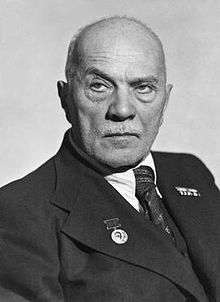Alexey Shchusev
| Alexey Viktorovich Shchusev | |
|---|---|
 | |
| Born |
8 October 1873 Kishenev, Bessarabia Governorate |
| Died |
24 May 1949 (aged 75) Moscow, Russian SFSR |
| Nationality |
Russian Empire Soviet Union |
| Occupation | Architect |
| Buildings |
Kazan Railway Station Lenin's Mausoleum |
Alexey Viktorovich Shchusev (Russian: Алексе́й Ви́кторович Щу́сев; 8 October [O.S. 26 September] 1873, – 24 May 1949) was an acclaimed Russian and Soviet architect whose works may be regarded as a bridge connecting Revivalist architecture of Imperial Russia with Stalin's Empire Style.
Biography
Shchusev studied under Leon Benois and Ilya Repin at the Imperial Academy of Arts in 1891–1897. From 1894 to 1899, he travelled in North Africa and Central Asia. Shchusev was a diligent student of old Russian art and won public acclaim with his restoration of the 12th-century St. Basil Church in Ovruch, Ukraine. He dwelt on 15th-century Muscovite architecture to design the Trinity Cathedral in Pochayiv Lavra and a memorial church on the Kulikovo Field. He was then commissioned by the Grand Duchess Elizabeth Feodorovna to design a cathedral for Marfo-Mariinsky Convent in Moscow. The result was a charming medieval structure of the purest Novgorodian style (1908–1912).[1]
Shchusev embarked upon his most wide-scale project in 1913, when his design for the Kazan Railway Station won a contest for a Moscow terminus of the Trans-Siberian Railway. This Art Nouveau design fused elements of the Kremlin towers and traditional Tatar architecture in one of the most imaginative Revivalist designs ever put to execution. The construction of the railway station, however, was not finished until 1940.
After briefly experimenting with Neoclassicism, Shchusev turned to Constructivism in the 1920s. He taught at Vkhutemas from 1920 through 1924. Upon Lenin's death in 1924, he was asked to design a mausoleum for him. It took him just several days to come up with an original architectural solution blending Constructivist elements with features taken from some ancient mausoleums, i.e., the Step Pyramid and the Tomb of Cyrus.
There are two notable Constructivist designs of Shchusev: the Ministry of Agriculture or Narkomzem in Moscow (1928–1933) and the Institute of Resorts in Sochi (1927–1931), considered to be a major source for Alvar Aalto's Paimio Sanatorium.

Mikhail Nesterov.
After the mausoleum commission, Shchusev was cherished by the Communist authorities. In 1926, he was nominated director of the Tretyakov Gallery. He was appointed head of the group that designed major bridges and apartment complexes in Moscow. His name was attached to the luxurious designs of the Hotel Moskva just a few steps from the Kremlin (1930–1938) and the NKVD headquarters on Lubyanka Square (1940–1947). Some say that he was the first to come up with the idea of Gothic skyscrapers in Moscow.
It is debated whether these Stalinist designs were really Shchusev's or if they were actually executed by his disciples. The discussion of their artistic merits was exacerbated when the Moscow authorities announced their intention to demolish the Hotel Moskva in 2004. Actually, all these designs, whether executed for Moscow, Tbilisi (such as a building of the Marx-Engels-Lenin Institute), or Tashkent, featured Shchusev's trademark blend of Neoclassical elements with national architectural traditions.
It is believed that the author of the Lenin Mausoleum in Moscow was one of the Shchusev’s office architect Isidore Frantsuz. According to Russian architectural historian Alexei Klimenko: "It was proven by architectural critic Selim Khan-Magomedov. The Soviet government did not want the public to know about the Jewish origin of the true author, and the work was credited to Shchusev".[2]
A. Klimenko, who was a graduate student at the institute, where Khan-Magomedov was working then, said that Khan-Magomedov "found the drawings, on which the name" Frantsuz " was scraped and on the top of it was written " A. Shchusev. " For that Khan-Magomedov was almost thrown out of the Communist party, and there was a scandal on the grounds of nationality: don’t trash their Jewish surnames into history of Soviet architecture in general, and the Red Square in particular”.[2]
There is another known case where Shchusev was accused of plagiarism. In 1937, the architects L. I. Saveliev and O. A. Stapran appealed to the Union of Architects with a complaint against Schusev alleging that he assumed the authorship of their "Moscow" hotel project. As a result of that complaint Shchusev was removed from the board of the Moscow branch of the Union of Architects.
In 1946, Shchusev established the Museum of Architecture, which helped to preserve remnants of demolished medieval churches and monasteries. His last works of importance were the Komsomolskaya station of the Moscow Metro, whose decoration was stylized after 17th-century Muscovite churches, and the plan for reconstruction of Novgorod after the ancient city had been destroyed by the Nazis (in recognition of that, one of Novgorod's modern streets was named after him). Shchusev died four years after the end of World War II and was buried at the Novodevichy Cemetery.
Awards and recognition
Shchusev was awarded the Stalin Prizes in 1941, 1946, 1948, and posthumously in 1952; the Order of Lenin and other orders and medals.
The Shchusev State Museum of Architecture in Moscow has been named after him.
Gallery


 Komsomolskaya station of the Moscow Metro (entrance)
Komsomolskaya station of the Moscow Metro (entrance)
References
- ↑ Brumfield, 2016: p. 16-24.
- 1 2 Вопрос «Труда»: Что делать с мавзолеем Щусева?
Bibliography
- Brumfield, William С. (2016), "New Directions in Russian Orthodox Church Architecture at the Beginning of the Twentieth Century" (PDF), Journal of Siberian Federal University. Humanities & Social Sciences, 9 (1), archived (PDF) from the original on 1 February 2016, retrieved 1 February 2016
External links
 Media related to Alexey Shchusev at Wikimedia Commons
Media related to Alexey Shchusev at Wikimedia Commons- Alexey Schusev's Constructivist Narkomzem building at galinsky.com
- Shchusev Museum of Architecture official website.